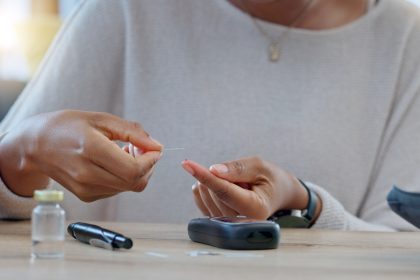Diabetes affects millions worldwide, and while most know about its impact on blood sugar and organ health, vision loss remains one of its most devastating complications. Understanding how diabetes threatens eyesight can help protect against preventable blindness and maintain long-term eye health through proper management and prevention strategies.
Diabetic retinopathy
The leading cause of blindness among diabetic adults, retinopathy occurs when high blood sugar damages tiny retinal blood vessels. These vessels may swell, leak, or close completely. As the condition progresses, abnormal vessels form, potentially causing severe vision problems or total blindness.
Early detection through regular eye exams significantly improves outcomes. Managing this complication requires consistent monitoring and blood sugar control. When caught early, treatments can effectively slow or stop vision loss, making regular screenings essential for anyone with diabetes.
Macular edema
When fluid leaks into the macula, the retina’s central portion responsible for sharp vision, it causes swelling and blurred sight. This condition, particularly common in those with prolonged or poorly managed diabetes, can lead to irreversible blindness if untreated.
Modern treatments include anti-VEGF injections and laser therapy to reduce swelling. However, consistent diabetes management provides the best defense against this complication. Regular monitoring helps detect early signs of macular edema before permanent damage occurs.
Cataracts
Diabetics often develop cataracts earlier than others. These cloudy formations in the eye’s lens create blurred or dimmed vision, potentially progressing to blindness without intervention. While surgery effectively removes clouded lenses, maintaining healthy blood sugar levels can delay onset.
The relationship between diabetes and early cataract development highlights the importance of comprehensive eye care. Regular examinations can track any changes in lens clarity, allowing for timely intervention when needed. Surgical outcomes generally remain positive, especially when performed before significant vision loss occurs.
Glaucoma
Diabetes doubles glaucoma risk, where increased eye pressure damages the optic nerve. Often called the “sneaky thief of sight,” glaucoma develops gradually without obvious early symptoms. Regular screenings enable early detection when treatment proves most effective.
Eye drops, medications, and surgical options help manage glaucoma. However, proactive diabetes care significantly reduces risk, highlighting prevention’s importance in vision protection. Understanding the connection between diabetes and glaucoma encourages vigilant monitoring of eye pressure and overall eye health.
Poor circulation
Diabetes-related circulation problems extend to the eyes. Restricted blood flow prevents retinal cells from receiving adequate oxygen and nutrients, leading to tissue damage and vision loss. Regular physical activity and heart-healthy nutrition improve circulation, reducing blindness risk from poor blood flow.
This systemic effect of diabetes demonstrates why whole-body health matters for vision protection. Improving circulation through lifestyle changes benefits not only eye health but overall well-being. Exercise, proper nutrition, and blood sugar control work together to maintain healthy blood flow to the eyes.
Neuropathy
While commonly associated with hand and foot nerve damage, diabetic neuropathy also affects the optic nerve. This damage can cause blurred or double vision, focusing difficulties, or complete sight loss without proper management. Maintaining healthy blood sugar levels helps slow neuropathy progression.
The impact of neuropathy on vision emphasizes diabetes’s far-reaching effects on the nervous system. Regular neurological assessments, combined with eye examinations, help monitor any changes in nerve function that might affect vision.
Increased infection risk
Diabetes weakens the immune system, making individuals more susceptible to eye infections like conjunctivitis or keratitis. Without proper treatment, these infections may cause corneal scarring and blindness. Good hygiene practices and prompt infection treatment help prevent vision-threatening complications.
Understanding this increased vulnerability helps patients recognize the importance of immediate attention to any eye irritation or infection symptoms. Proper hygiene, regular hand washing, and avoiding eye rubbing reduce infection risks.
Prevention and management strategies
While diabetes creates significant vision risks, blindness isn’t inevitable. Consider these protective measures:
Monitor blood sugar levels consistently and keep them within recommended ranges. High blood sugar accelerates eye damage, making control essential for vision protection.
Schedule regular dilated eye examinations. These comprehensive checks catch problems early when treatment proves most effective.
Control blood pressure diligently. Hypertension compounds diabetes-related eye problems, making management crucial for vision health.
Practice healthy lifestyle choices, including regular exercise, balanced nutrition, and smoking cessation, to improve overall health and protect vision.
The importance of early intervention
Understanding diabetes-related vision risks empowers better health decisions. Regular medical care, consistent blood sugar monitoring, and prompt attention to eye problems help prevent or minimize vision loss.
Share this knowledge with others affected by diabetes. Early awareness and action provide the best protection against preventable blindness. Remember, vision preservation starts with education and continues through consistent care.
The connection between diabetes and vision health emphasizes the need for comprehensive disease management. Through proper care, regular monitoring, and lifestyle modifications, individuals with diabetes can significantly reduce their risk of vision loss and maintain healthy sight throughout their lives.
This story was created using AI technology.














